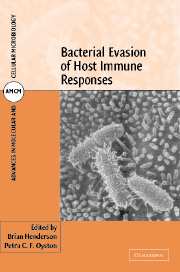Book contents
- Frontmatter
- Contents
- Contributors
- Preface
- Part I Recognition of bacteria
- Part II Evasion of humoral immunity
- Part III Evasion of cellular immunity
- 7 Type III secretion and resistance to phagocytosis
- 8 Bacterial superantigens and immune evasion
- 9 Bacterial quorum sensing signalling molecules as immune modulators
- 10 Microbial modulation of cytokine networks
- 11 Enterotoxins: Adjuvants and immune inhibitors
- 12 Type III protein secretion and inhibition of NF-κB
- Index
- Plate section
- References
8 - Bacterial superantigens and immune evasion
from Part III - Evasion of cellular immunity
Published online by Cambridge University Press: 13 August 2009
- Frontmatter
- Contents
- Contributors
- Preface
- Part I Recognition of bacteria
- Part II Evasion of humoral immunity
- Part III Evasion of cellular immunity
- 7 Type III secretion and resistance to phagocytosis
- 8 Bacterial superantigens and immune evasion
- 9 Bacterial quorum sensing signalling molecules as immune modulators
- 10 Microbial modulation of cytokine networks
- 11 Enterotoxins: Adjuvants and immune inhibitors
- 12 Type III protein secretion and inhibition of NF-κB
- Index
- Plate section
- References
Summary
INTRODUCTION
Vertebrates and microbes live together in a precarious balancing act. Staphylococcus aureus and Streptococcus pyogenes are Gram-positive commensal bacteria that inhabit the human skin, nose, and upper respiratory tract (Wannamaker and Schlievert 1988) and for the most part live an unremarkable, symbiotic existence with humans. Both organisms produce superantigens (SAGs) Table 8.1 that simultaneously bind to the T-cell Receptor (TcR) and the major histocompatibility class II (MHC-II) antigens – two molecules central to host immunity – bringing them together to cause profound T-cell activation (Schlievert, 1993; Marrack and Kappler, 1990; Kotzin et al., 1993; Fleischer, 1994; Acha Orbea and MacDonald, 1995). Any T cell bearing a reactive TcR β-chain becomes a target for a SAG and with only sixty-five TcR β-chain genes resident in the human genome (Rowen et al., 1996), any individual SAG stimulates at least 1–2% of peripheral T cells and often more than this. Superantigen activation produces toxic levels of the pro-inflammatory cytokines Interleukin (IL)-1β, tumour necrosis factor (TNF)-α, and interleukin-2 (IL-2) (see Chapter 10 for more details on cytokines), which can lead to the potentially lethal condition known as toxic shock. SAGs are not limited to S. aureus and S. pyogenes. Versions of SAGs have also been found in a number of other organisms and all cross-link TcR and MHC class II to overstimulate T-lymphocytes
Although a great deal is known about the structure and mode of action of the bacterial SAGs, little is known about how they act to enhance the survival of bacteria and how they might disrupt the host immune responses to other antigens.
- Type
- Chapter
- Information
- Bacterial Evasion of Host Immune Responses , pp. 171 - 200Publisher: Cambridge University PressPrint publication year: 2003
References
- 1
- Cited by

